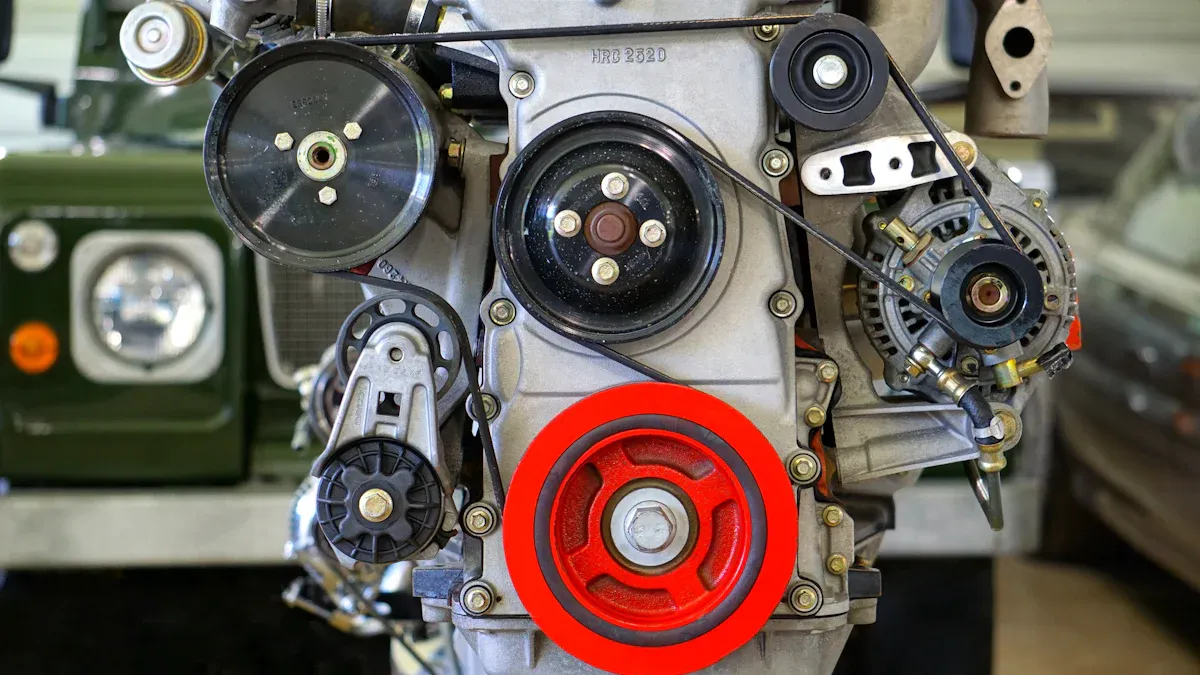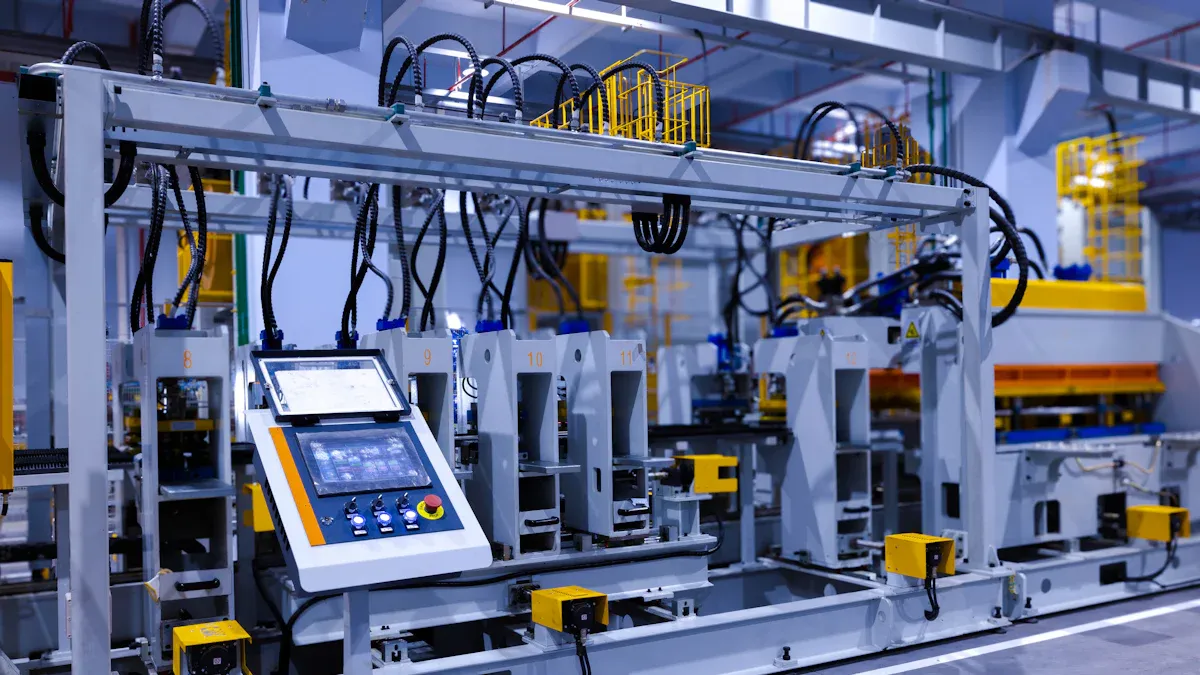Author:
-
Position:
General Manager of Foreign Trade Department, Taojun Refrigeration -
Professional Experience:
Engaged in international trade within the refrigeration industry since 2004.
Expert in brand strategy and omni-channel marketing, having led three multi-million yuan projects that boosted brand exposure by over 200%.
-
Core Competencies:
Proficient in data analysis and user growth strategies.
Skilled in SEO/SEM and social media management tools.
Experienced in cross-departmental collaboration and team leadership.
-
Philosophy:
"Data-driven decisions, creativity-powered branding." Committed to achieving business value and user experience excellence through refined operations. -
Vision:
Eager to collaborate with partners to explore emerging market opportunities and set industry benchmark cases.
Contact Us to Find More Products
B2B Buyers Guide: 2025 Market Trends in Refrigerator Fan Motor Manufacturing

Refrigerator fan motor manufacturing is poised for transformative growth in 2025, driven by technological innovation, sustainability efforts, and evolving market dynamics. Several factors contribute to this upward trajectory:
- The global refrigerator motors market is forecasted to grow from USD 5.2 billion in 2023 to USD 8.6 billion by 2032, with a compound annual growth rate (CAGR) of 6.0%.
- Asia Pacific leads the market, accounting for 40% of the global share in 2023, fueled by urbanization and rising middle-class demand.
- Europe’s stringent energy efficiency regulations support a CAGR of 5.0% from 2024 to 2032, emphasizing sustainable appliance adoption.
The integration of advanced motor technologies, such as inverter systems, enables variable-speed motors to optimize energy consumption, aligning with global sustainability goals.
These trends reflect a pivotal shift toward efficiency, compliance, and innovation, shaping the future of refrigerator fan motor manufacturing.
Key Takeaways
- The market for refrigerator Fan Motors will grow a lot, reaching $15 billion by 2025. This growth is due to energy-saving tech and smart home features.
- Asia Pacific is the biggest player, making up 40% of the market. Urban growth and more need for cooling in developing countries drive this trend.
- Using energy-saving motors can cut costs and meet eco-friendly rules. This helps both the planet and your wallet.
- Picking suppliers with good reputations and proper certifications ensures reliable and high-quality products. This is key for long-term success.
- Keep track of market changes and new rules to stay ahead in the refrigerator fan motor business.
2025 Market Landscape in Refrigerator Fan Motor Manufacturing
Market Growth and Forecasts
The refrigerator fan motor manufacturing industry is on a robust growth trajectory, driven by technological advancements and evolving consumer preferences. Historical data reveals consistent expansion, with the market projected to reach $15 billion by 2025 and $23 billion by 2033. This represents a steady compound annual growth rate (CAGR) of 5% from 2025 to 2033.
| Metric | Value |
|---|---|
| Estimated market size in 2025 | $15 billion |
| Projected market size by 2033 | $23 billion |
| Compound Annual Growth Rate (CAGR) | 5% from 2025 to 2033 |
The adoption of brushless DC motors and other energy-efficient technologies is accelerating this growth. These innovations align with global trends toward sustainability and automation, ensuring the industry's relevance in a rapidly digitalizing world.
Demand Drivers
Several factors are fueling the demand for refrigerator fan motor manufacturing. The increasing adoption of energy-efficient appliances is a primary driver, as consumers and businesses prioritize sustainability. The rise of smart home technologies has also contributed to the demand for advanced motor systems that integrate seamlessly with IoT-enabled devices.
- The global refrigerator motor market is projected to reach $5 billion by 2025.
- It is expected to exhibit a CAGR of 6% from 2025 to 2033.
- Growth is driven by the adoption of refrigerators in developing economies and the need for energy-efficient solutions.
Quantitative analyses, including correlation and regression studies, highlight the impact of these factors on market demand. Additionally, industry reports emphasize the importance of regional and application-specific trends in shaping the market landscape.
Emerging Regions
Emerging markets play a pivotal role in the growth of refrigerator fan motor manufacturing. Asia Pacific leads the charge, accounting for 40% of the global market share in 2023. Urbanization and a growing middle class in countries like China and India are driving demand for refrigerators and their components.
In addition to Asia Pacific, regions such as South America and Africa are witnessing increased adoption of refrigeration technologies. These markets benefit from rising disposable incomes and expanding infrastructure, creating opportunities for manufacturers to establish a foothold.
Tip: Businesses looking to expand into emerging regions should consider partnerships with local distributors and compliance with regional regulations to maximize market penetration.
Technological Advancements in Refrigerator Fan Motor Manufacturing

Innovations in Fan Motor Design
The refrigerator fan motor manufacturing industry is witnessing groundbreaking innovations in motor design. Manufacturers are increasingly adopting intelligent control systems that integrate sensors and control modules. These systems enable remote monitoring and predictive maintenance, reducing downtime and enhancing operational efficiency. Advanced motor applications, such as electronically commutated (EC) motors, are also gaining traction. These motors offer intelligent speed regulation, resulting in quieter operation and significant energy savings.
Noise reduction remains a critical focus area. Improved blade geometries and advanced materials are helping manufacturers develop low-noise designs, which are particularly beneficial for HVAC systems and data centers. These innovations not only improve performance but also align with the growing demand for sustainable and user-friendly appliances.
Energy Efficiency Enhancements
Energy efficiency has become a cornerstone of modern refrigerator fan motor manufacturing. The global cold chain fans market, valued at approximately $1.5 billion in 2025, is expected to grow at a CAGR of 7% through 2033. This growth is driven by advancements in energy-efficient technologies, stricter regulatory compliance, and the rising demand for perishable goods.
Manufacturers are leveraging EC motors and inverter technologies to optimize energy consumption. These advancements allow motors to operate at variable speeds, reducing energy waste and lowering operational costs. Such innovations not only meet regulatory requirements but also cater to environmentally conscious consumers seeking sustainable solutions.
Note: Businesses investing in energy-efficient fan motors can benefit from reduced energy costs and enhanced compliance with global sustainability standards.
IoT Integration
The integration of IoT technology is revolutionizing refrigerator fan motor manufacturing. IoT-enabled motors now feature real-time monitoring capabilities, allowing users to track performance metrics and identify potential issues before they escalate. This predictive approach minimizes maintenance costs and extends the lifespan of the equipment.
Smart home technologies are further driving the adoption of IoT-integrated fan motors. These motors seamlessly connect with other smart devices, enabling centralized control and automation. For instance, users can adjust motor speeds or monitor energy usage through mobile applications, enhancing convenience and efficiency.
IoT integration not only improves functionality but also positions manufacturers at the forefront of technological innovation, meeting the evolving needs of modern consumers.
Sustainability Practices in Refrigerator Fan Motor Manufacturing

Eco-Friendly Manufacturing
Eco-friendly manufacturing has become a cornerstone of modern refrigerator fan motor production. Companies are adopting sustainable practices to reduce environmental impact while meeting consumer demand for greener products. The use of recyclable materials, such as bio-based plastics, has significantly lowered waste and carbon emissions compared to traditional materials. Additionally, innovations like brushless DC motors have improved energy efficiency by up to 30%, making refrigeration systems more sustainable.
| Metric | Description |
|---|---|
| Energy Efficiency | Innovations like brushless DC motors can lead to energy savings of up to 30% in refrigeration applications. |
| Use of Recyclable Materials | Adoption of bio-based plastics reduces waste and lowers carbon footprint compared to traditional materials. |
| Eco-friendly Refrigerants | The shift towards sustainable refrigerants aligns with global environmental standards. |
Rising consumer awareness of environmental issues has further driven demand for energy-efficient appliances. Companies prioritizing sustainability gain a competitive edge in the market, as eco-conscious buyers increasingly favor brands that align with their values.
Environmental Compliance
Environmental compliance plays a critical role in refrigerator fan motor manufacturing. Regulatory frameworks ensure that manufacturers adhere to environmental standards, minimizing their ecological footprint. Key regulations include the Toxic Substances Control Act (TSCA), which governs the use of chemicals, and the Significant New Alternatives Policy (SNAP), which promotes environmentally friendly refrigerants.
| Regulation | Description |
|---|---|
| TSCA | Regulates the introduction of new or existing chemicals, including refrigerants, to manage environmental impacts. |
| SNAP | Identifies and approves environmentally friendly alternatives to high-global warming potential substances in refrigeration. |
| EPA 608 | Focuses on the management of ozone-depleting substances and refrigerants, ensuring compliance with air quality standards. |
Manufacturers that comply with these regulations not only contribute to environmental preservation but also enhance their reputation in the global market. Compliance ensures alignment with international standards, fostering trust among stakeholders.
Renewable Energy Adoption
The adoption of renewable energy is transforming the refrigerator fan motor manufacturing industry. Companies are increasingly integrating renewable energy sources into their operations to reduce reliance on fossil fuels. The global market for energy-efficient motors, valued at $48.5 billion in 2022, is projected to reach $119.1 billion by 2032, growing at a compound annual growth rate (CAGR) of 9.5%.
| Year | Market Size (in billion USD) | CAGR (%) |
|---|---|---|
| 2023 | 2.7 | 6.5 |
| 2032 | 4.8 |
The shift towards renewable energy aligns with global sustainability goals and enhances operational efficiency. By leveraging renewable energy, manufacturers can lower production costs and reduce greenhouse gas emissions, contributing to a cleaner environment.
Competitive Landscape in Refrigerator Fan Motor Manufacturing
Leading Manufacturers
The refrigerator fan motor manufacturing industry is dominated by a few key players who have established themselves through innovation, energy efficiency, and strategic partnerships. Companies like Johnson Electric Holdings Limited, Nidec Corporation, and Siemens AG lead the market with their robust research and development capabilities and global reach.
| Company Name | Key Focus Areas | Competitive Advantage |
|---|---|---|
| Johnson Electric Holdings Limited | Innovation, Energy Efficiency | Strong R&D capabilities, global presence |
| Nidec Corporation | Technological Innovation, Sustainability | Comprehensive portfolio, alignment with market trends |
| Siemens AG | Reliability, Performance, Energy Efficiency | Expertise in electrical engineering, strategic partnerships |
These manufacturers have consistently delivered high-quality products that meet the evolving demands of the market. Their focus on energy-efficient technologies and compliance with environmental regulations has further solidified their leadership positions.
Market Strategies
Leading companies employ diverse strategies to maintain their competitive edge. Many focus on expanding their product portfolios to cater to a broader range of applications, including HVAC systems, industrial ventilation, and consumer electronics. For instance, Ebm-papst and Delta Group, two prominent manufacturers, have captured significant market shares by targeting niche applications.
| Manufacturer | Market Share | Key Applications |
|---|---|---|
| Ebm-papst | 17% | HVAC, electronics, industrial ventilation systems |
| Delta Group | 14% | Data centers, telecommunications, consumer electronics |
Strategic partnerships and acquisitions also play a crucial role. Companies collaborate with technology providers to integrate advanced features like IoT and AI into their products. Additionally, investments in renewable energy and sustainable manufacturing practices align with global trends, enhancing their market appeal.
Emerging Competitors
The competitive landscape is evolving as new players enter the market, leveraging innovative technologies and cost-effective solutions. Emerging competitors often focus on specific niches or underserved regions, challenging established manufacturers.
| Evidence Type | Description |
|---|---|
| Historical Market Size | Analysis from 2017 to 2023, providing context on market growth and trends. |
| Competitive Analysis | Insights into key players and their market positioning, strengths, and weaknesses. |
| PESTLE Analysis | Examination of external factors affecting the market, including political, economic, social, technological, legal, and environmental aspects. |
| Financial Metrics | Understanding of competitors' financial performance to gauge their impact on the market. |
| Market Dynamics | Insights into trends and consumer behavior that influence market direction. |
These emerging players often capitalize on regional opportunities, such as the growing demand for refrigeration technologies in South America and Africa. By adopting agile business models and focusing on innovation, they are reshaping the competitive dynamics of refrigerator fan motor manufacturing.
Purchasing Guide for B2B Buyers
Supplier Evaluation
Selecting the right supplier is critical for businesses in refrigerator fan motor manufacturing. Buyers should assess suppliers based on their reliability, product quality, and ability to meet delivery timelines. A thorough evaluation ensures that the supplier aligns with the buyer's operational goals and quality expectations.
Key factors to consider during supplier evaluation include:
- Experience and Reputation: Suppliers with a proven track record in the industry often deliver consistent quality. Researching customer reviews and case studies can provide valuable insights.
- Production Capacity: Assessing a supplier's production capabilities ensures they can meet both current and future demand.
- Certifications and Compliance: Suppliers adhering to international standards demonstrate their commitment to quality and safety. Certifications such as ISO 9001 and UL’s Recognized Component Mark indicate compliance with stringent requirements.
Tip: Establishing long-term partnerships with reliable suppliers can lead to better pricing, improved communication, and consistent product quality.
Cost and Budget Considerations
Cost plays a pivotal role in the decision-making process for B2B buyers. However, focusing solely on price can lead to compromises in quality or reliability. Buyers should adopt a balanced approach, considering both cost-effectiveness and long-term value.
Steps to manage costs effectively:
- Total Cost of Ownership (TCO): Evaluate not just the purchase price but also maintenance, energy consumption, and lifecycle costs. Energy-efficient motors, for instance, may have a higher upfront cost but result in significant savings over time.
- Volume Discounts: Negotiating bulk purchase agreements can reduce per-unit costs.
- Market Trends: Monitoring market dynamics helps buyers identify optimal purchasing windows, especially during periods of stable raw material prices.
Note: Investing in high-quality components may initially seem expensive but often reduces operational disruptions and maintenance expenses in the long run.
Quality Standards and Certifications
Adherence to quality standards and certifications is essential in refrigerator fan motor manufacturing. These benchmarks ensure that products meet safety, performance, and environmental requirements. Buyers should prioritize suppliers who comply with recognized certifications to guarantee product reliability and regulatory compliance.
| Certification | Description |
|---|---|
| UL’s Recognized Component Mark | Indicates compliance with North American requirements. |
| UL’s D Mark | Demonstrates adherence to EN and/or IEC standards for components and products. |
| D Mark Built-In Part Certification | Covers fans, motors, and heating elements evaluated to relevant EN/IEC standards. |
Certifications like these not only validate product quality but also enhance the buyer's confidence in the supplier's capabilities. Additionally, compliance with environmental regulations, such as the EU ROHS directive, ensures that products align with global sustainability goals.
Callout: Always request documentation of certifications and audit reports during the supplier evaluation process to verify compliance.
The refrigerator fan motor manufacturing industry in 2025 is shaped by innovation, sustainability, and evolving market demands. Key drivers include the rising adoption of energy-efficient technologies, IoT integration, and eco-friendly manufacturing practices.
| Key Market Drivers | Description |
|---|---|
| Electrified HVAC Systems | 45% year-over-year growth in electrified HVAC systems in commercial vehicles. |
| Eco-Friendly Refrigerants | Transition to low-GWP refrigerants to cut emissions by 50% by 2025. |
| Refrigerated Transport Demand | Cold chain logistics projected to grow 22% annually through 2026. |
B2B buyers should prioritize suppliers with proven expertise, certifications, and sustainable practices. Staying informed about market trends and fostering partnerships with reliable manufacturers ensures long-term success.
Tip: Regularly monitor regulatory updates and emerging technologies to maintain a competitive edge.
FAQ
What are the key factors driving the growth of the refrigerator fan motor market in 2025?
The market is growing due to rising demand for energy-efficient appliances, IoT integration, and eco-friendly manufacturing practices. Emerging markets in Asia Pacific and Africa also contribute significantly to this growth.
How does IoT integration benefit refrigerator fan motors?
IoT integration enables real-time monitoring, predictive maintenance, and centralized control. These features reduce downtime, extend motor lifespan, and enhance energy efficiency, meeting modern consumer needs.
What certifications should buyers look for when selecting a supplier?
Buyers should prioritize suppliers with certifications like ISO 9001, UL’s Recognized Component Mark, and EU ROHS compliance. These certifications ensure product quality, safety, and adherence to environmental standards.
Why is energy efficiency important in refrigerator fan motors?
Energy-efficient motors reduce operational costs and environmental impact. Technologies like brushless DC motors and inverters optimize energy consumption, aligning with global sustainability goals.
How can businesses ensure reliable supplier partnerships?
Businesses should evaluate suppliers based on experience, production capacity, and certifications. Long-term partnerships with reliable suppliers often lead to better pricing, consistent quality, and improved communication.








